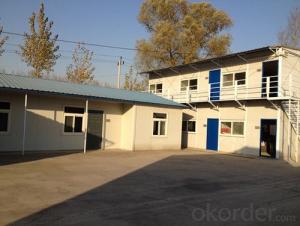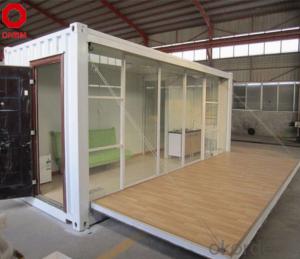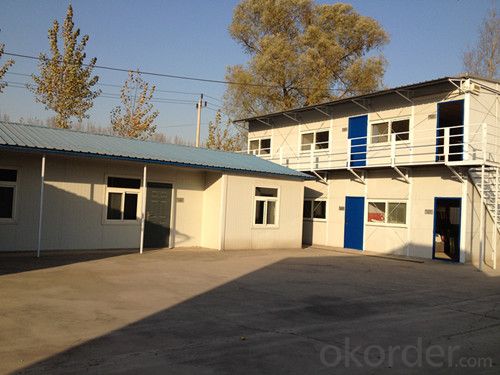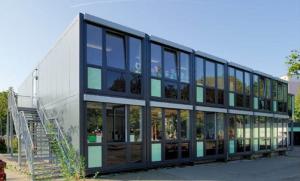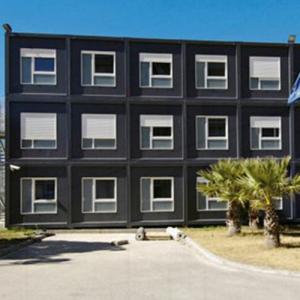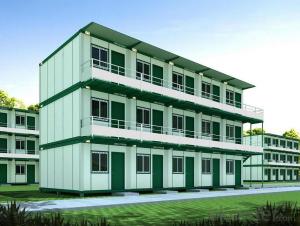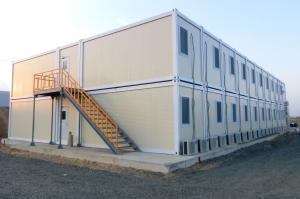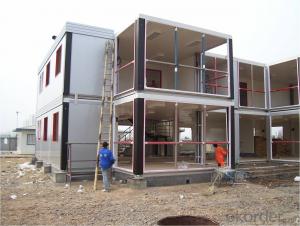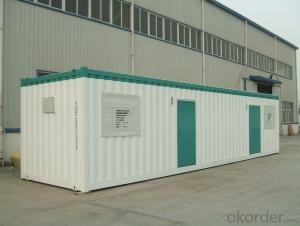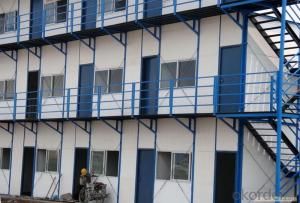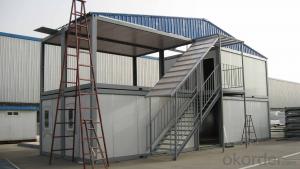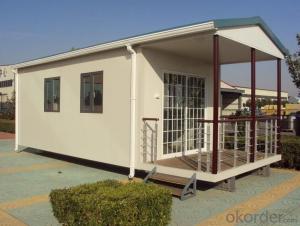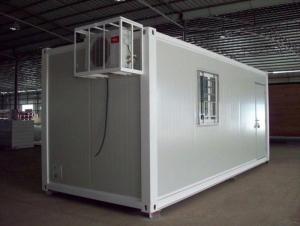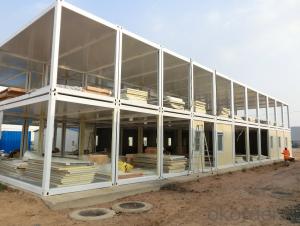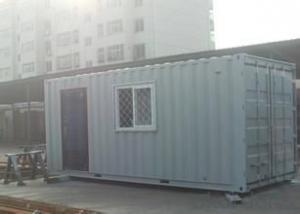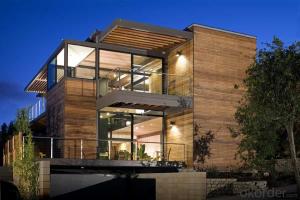Container House Made of Sandwich Pannel
- Loading Port:
- Tianjin
- Payment Terms:
- TT OR LC
- Min Order Qty:
- 100 m²
- Supply Capability:
- 100000 m²/month
OKorder Service Pledge
OKorder Financial Service
You Might Also Like
Container House Made of Sandwich Pannel:
1. Brief Description of Container House Made of Sandwich Pannel:
Our modular steel structural container semi trailer with side wall pannel will be your best choice to use long life and it is strong and stable,it can resist big wind,hurricane,heavy snow,rainstorm.it is no problem to use more than 25 years.And my product will help you to develop a good market in your country.
2. Main Features of Container House Made of Sandwich Pannel:
1.No base work involved,easy to install
2.Environment protective, no garbage caused
3.Doors, windows, and interior partitions can be flexibly fixed
4.Beautiful appearance, different colors for the wall and roof
5.Cost saving and transportation convenient
6.Can be reused relocated and even resold .
7.Anti-rust and normally more than 15 years using life
3. Main Specification of Container House Made of Sandwich Pannel:
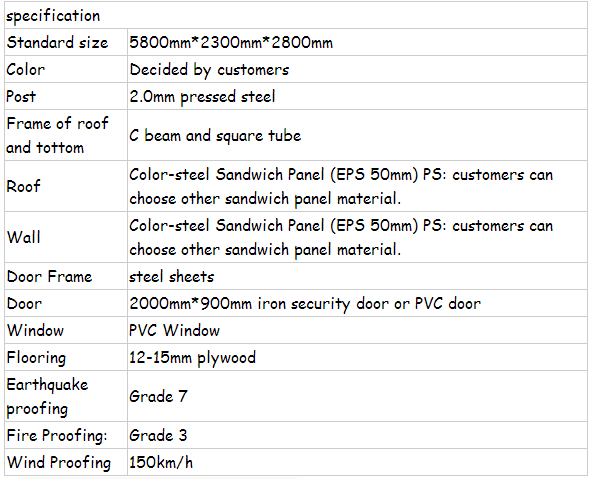
4.Pictures of Container House Made of Sandwich Pannel:
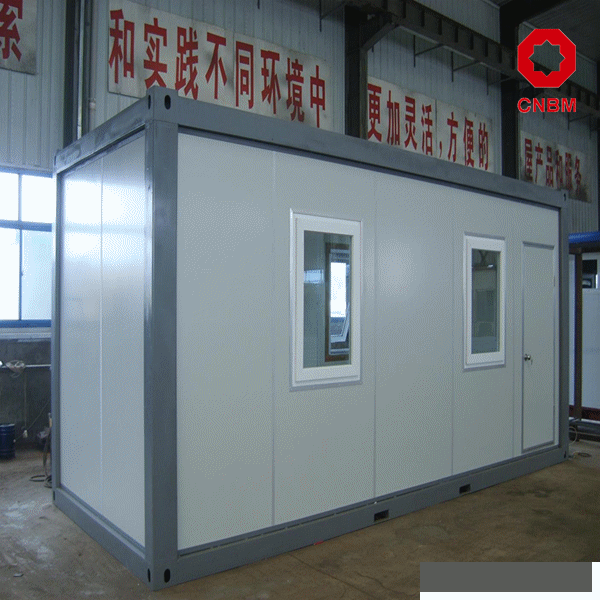
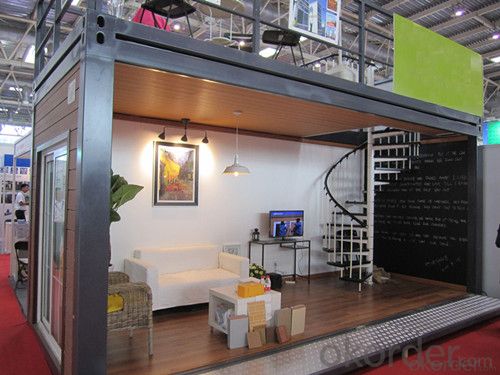
5.FAQ
Q1:What is the MOQ?
3 UNITS
Q2:How many units can be loaded in one container?
3 UNITS can be loaded by a 20ft container,8 units can be loaded by a 40'HQ container.
Q3:What is the delivery time?
We can delivery the goods within 25 workdays.
Q4:Payment terms?
We can accept T/T and L/C.30% before production,and 70% after check the goods before shipped.
- Q: Can container houses be rented?
- Yes, container houses can be rented. Many companies and individuals offer container houses for rent as an alternative housing option. These rental container houses are typically equipped with basic amenities such as electricity, plumbing, and insulation, making them suitable for temporary or long-term living arrangements. Renting a container house can be a cost-effective and sustainable option for individuals or families looking for unique and flexible housing solutions.
- Q: Can container houses be designed with a meditation or yoga space?
- Absolutely! Container houses have the potential to incorporate a dedicated meditation or yoga space. They offer great customization options, allowing the inhabitants to modify the space according to their specific needs and preferences. By employing a little creativity and thoughtful design, it is easily achievable to integrate a meditation or yoga area into a container house. The key to designing such a space in a container house lies in giving prominence to tranquility, peace, and serenity. This can be accomplished by selecting a secluded and quiet spot within the house, away from any noise or distractions. Container houses can be designed with an open floor plan, which provides the flexibility to create a designated meditation or yoga area. By using different materials like bamboo flooring or a soothing color palette, this space can be visually distinct from the rest. Natural light also plays a crucial role in creating a calming atmosphere. Incorporating large windows or skylights into the design allows for ample natural light, known to enhance the meditation and yoga experience. Apart from this, proper ventilation and insulation ensure a comfortable and refreshing environment for these practices. Storage is another key consideration. A meditation or yoga space requires storage for yoga mats, meditation cushions, and other accessories. To keep these items easily accessible and organized while maximizing the use of space, built-in shelves or cabinets can be installed. Lastly, incorporating elements of nature such as plants or a small indoor fountain can enhance the overall ambiance of the meditation or yoga space. These natural elements contribute to the calming and grounding effect, making the meditation or yoga experience more immersive and fulfilling. In conclusion, container houses can be uniquely designed to accommodate a meditation or yoga space. With careful planning and attention to detail, it is certainly possible to create a serene and tranquil environment within a container house that promotes relaxation, mindfulness, and spiritual well-being.
- Q: Can container houses be built with a flat roof or a pitched roof?
- Yes, container houses can be built with either a flat roof or a pitched roof. The choice between the two depends on various factors such as personal preference, climate conditions, and the intended use of the container house. A flat roof design is commonly used in container houses due to its simplicity and cost-effectiveness. It provides a modern and minimalist aesthetic, and it allows for easy installation of solar panels or rooftop gardens. However, it is important to ensure proper insulation and waterproofing to prevent leakage and heat transfer. On the other hand, a pitched roof design can add a traditional or architectural touch to a container house. It offers better drainage, snow load resistance, and natural ventilation. Additionally, a pitched roof allows for the installation of attic space or loft areas, providing more interior vertical space. However, constructing a pitched roof may require additional structural modifications and expertise. Ultimately, the choice between a flat roof or a pitched roof for a container house depends on the specific requirements and preferences of the homeowner. Consulting with a professional architect or contractor can help determine the most suitable roof design for the container house project.
- Q: Can container houses be designed to have a high ceiling?
- Certainly! Container houses have the potential to feature a lofty ceiling design. Although conventional shipping containers are typically equipped with an 8-foot ceiling, they can be altered and stacked in a manner that creates a roomy and breezy interior with elevated ceilings. Through the elimination of the container's roof and the incorporation of supplementary structural support, it becomes feasible to elevate the ceiling height in accordance with specific design preferences. Moreover, the inclusion of windows or skylights serves to augment the perceived height and welcome natural light, thus imparting a sense of openness and expansiveness to the space. By conducting thorough planning and tailoring the design to individual needs, container houses can indeed boast high ceilings, thereby presenting a contemporary, fashionable, and cozy living environment.
- Q: Are container houses suitable for artists' studios or workshops?
- Artists can indeed find container houses suitable for their studios or workshops. There are several reasons why container houses make a great choice for artists. To begin with, container houses offer a cost-effective solution for artists who need a dedicated workspace. Renting or constructing traditional studio or workshop spaces can be quite expensive, especially in urban areas. Container houses provide a more affordable alternative, allowing artists to save money and invest more in their art. Moreover, container houses are highly versatile and can be easily customized. Artists can easily modify the interior of a container to create the ideal space for their specific requirements. They can add windows for natural light, insulation for temperature control, and partition walls for separate work areas. Containers can be transformed into spacious and well-lit studios or workshops that cater to various artistic practices. Furthermore, container houses are portable and can be easily moved or transported to different locations. This mobility can be advantageous for artists who need to work in different environments or travel for exhibitions or residencies. Being able to relocate their workspace allows artists to adapt to changing needs and explore new creative opportunities. Additionally, container houses are eco-friendly as they are repurposed shipping containers. By utilizing existing structures, artists contribute to sustainable practices by reducing waste and minimizing their carbon footprint. However, it's important to consider that container houses may have certain limitations. Size can be a constraint as containers come in standard dimensions, making it challenging for artists with large-scale or messy projects to work within these constraints. Moreover, noise insulation might be a concern, particularly for artists using loud equipment or musical instruments. In conclusion, container houses offer numerous benefits for artists' studios or workshops, including affordability, customization options, portability, and environmental sustainability. They provide a unique and innovative solution for artists seeking a dedicated space to create. With careful planning and consideration, container houses can be a perfect fit for many artists' needs.
- Q: How do container houses compare to traditional houses in terms of construction time?
- Container houses typically have a significant advantage over traditional houses when it comes to construction time. Due to the pre-fabricated nature of shipping containers, they can be quickly and easily modified to create a living space. The construction process involves mainly converting and joining containers, which reduces the need for extensive foundation work and structural framing. As a result, container houses can be assembled and completed in a fraction of the time it takes to build a traditional house. Additionally, container houses have the advantage of being able to be constructed off-site, allowing for simultaneous work on the site and the container, further reducing construction time. Overall, container houses offer a much quicker construction timeline compared to traditional houses, making them a popular choice for those seeking a fast and efficient housing solution.
- Q: Are container houses insulated?
- Yes, container houses can be insulated. Insulation is an important aspect of container house construction as it helps regulate temperature, reduces energy consumption, and creates a comfortable living environment. There are several insulation options available for container houses, including spray foam insulation, rigid foam insulation, and fiberglass insulation. These insulation materials are typically applied to the walls, floors, and ceilings of the container to prevent heat transfer and maintain a consistent indoor temperature. Additionally, insulation also helps in soundproofing the container house, making it more quiet and peaceful.
- Q: Can container houses be designed with a balcony or deck?
- Container houses can certainly have a balcony or deck. Numerous architects and designers have ingeniously integrated outdoor spaces into container house designs. To incorporate balconies and decks, one can extend the structure by adding more containers or construct a steel frame to support the outdoor area. These outdoor spaces offer an ideal chance to appreciate the surroundings, host guests, or simply unwind outdoors. Moreover, the inclusion of balconies and decks in container house designs enhances the space's aesthetic appeal and overall functionality.
- Q: What types of materials are used in container house construction?
- Container houses are becoming increasingly popular due to their affordability, sustainability, and flexibility. These houses are constructed using various types of materials to ensure their structural integrity and durability. The primary material used in container house construction is steel. Shipping containers are made of high-quality steel, which provides strength and stability to the structure. Steel is known for its durability and resistance to harsh weather conditions, making it an ideal choice for container houses. Insulation is another crucial material used in container house construction. The walls, floor, and roof of the containers are insulated to regulate temperature and improve energy efficiency. Materials like polyurethane foam, mineral wool, or polystyrene are commonly used for insulation purposes. To enhance the aesthetics and functionality of container houses, various other materials are employed. These include wood, which is used for flooring, cabinetry, and wall coverings. Additionally, fiberglass or PVC panels can be used to clad the exterior walls of the containers, providing additional insulation and protecting the steel from corrosion. For the roof, materials such as asphalt shingles, metal sheets, or green roofs can be chosen depending on the desired look and functionality. Windows and doors are typically made of aluminum or uPVC, offering durability, energy efficiency, and security. Other materials used in container house construction may include plumbing and electrical components such as PVC pipes, wiring, and fixtures. These materials ensure the proper functioning of utilities within the container house. In summary, container houses are constructed using a combination of steel, insulation materials, wood, fiberglass or PVC panels, roofing materials, windows and doors, and various plumbing and electrical components. The selection of these materials is crucial to ensure the structural integrity, energy efficiency, and overall aesthetics of the container house.
- Q: Are container houses subject to building codes and regulations?
- Container houses must adhere to building codes and regulations, despite their unique construction. These structures are subject to the same rules as traditional homes or buildings. The specific regulations may differ depending on the location, but they typically encompass safety, structural integrity, energy efficiency, fire protection, electrical and plumbing systems, and occupancy standards. Given that container houses are often created from repurposed shipping containers, adjustments may be necessary to meet the building code criteria. It is crucial to consult with local authorities or engage a professional architect or engineer to guarantee compliance with all regulations and to obtain the necessary permits before starting construction or occupancy.
Send your message to us
Container House Made of Sandwich Pannel
- Loading Port:
- Tianjin
- Payment Terms:
- TT OR LC
- Min Order Qty:
- 100 m²
- Supply Capability:
- 100000 m²/month
OKorder Service Pledge
OKorder Financial Service
Similar products
Hot products
Hot Searches
Related keywords
